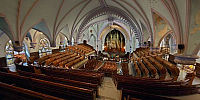
Sound -> Color Synesthesia
Montreal, Québec, Canada
September, 22, 2008 - 15:07 PM Local Time
© 2008 Eduardo Hutter, All Rights Reserved.
It can occur between nearly any two senses or perceptual modes, for example, grapheme -> color synesthesia, where individual letters and numbers are perceived as "shaded" or "tinged" with a color ("When people ask me about the sensation, they might ask, 'so when you look at a page of text, it's a rainbow of color?' It isn't exactly like that for me. When I read words, about five words around the exact one I'm reading are in color. It's also the only way I can spell. I remember in elementary school remembering how to spell the word 'priority' because the color scheme, in general, was darker than many other words. I would know that an 'e' was out of place in that word because e's were yellow and didn't fit."); or sound -> color synesthesia where individuals experience colors in response to tones or other aspects of sounds. In narrow band sound -> color synesthesia (often called music -> color synesthesia), musical stimuli (e.g., timbre or key) will elicit specific color experiences, such that a particular note will always elicit red, or harps will always elicit the experience of seeing a golden color.
Color changes in response to different aspects of sound stimuli may involve more than just the hue of the color. Any dimension of color experience (e.g., in HSL color space) can vary. Brightness (the amount of white in a color; as brightness is removed from red, for example, it fades into a brown and finally to black), saturation (the intensity of the color; fire engine red and medium blue are highly saturated, while grays, white, and black are all unsaturated), and hue may all be affected to varying degrees. Additionally, music -> color synesthetes, unlike grapheme -> color synesthetes, often report that the colors move, or stream into and out of their field of view.
The church
Designated a National historic site by the Canadian government, the Saint James United Church has a strucking beauty and is fairly classified as a "must see" by the Inventaire des lieux de culte du Québec. The church has great acoustics - while doing the panorama, I could hear the silent steps and the whispers from people down on the nave like they were coming from back of the balcony - and is the stage for three major musical festivals in Montreal: Orgue et Couleurs ("Organ and Colors"); Montreal Chamber Music Festival and the Festival Bach.
You can hear the Choir of Saint James United Church, Montreal, every sunday morning at 11:00 AM on their celebration.
http://www.stjamesunitedchurchmontreal.com/ - Official site of the Saint James Unitec Church
http://tinyurl.com/49fxva - Canadian Architect
Soft: PTGui 7.2; Photoshop CS2 and Pano2QTVR 1.6.6 Pro.
To my deception, the long stretch of grass that on the 2006 event was something around 200 or 300 meters long, had horribly shrunk to a tiny patch of 2x2 meters flooring some expositor kiosk! Nice way to humanize the landscape and have commuters regaining the streets, eh?
So, after wandering around for sometime I find myself inside the Saint James United Church to discover its beauty. So many times I have passed in front of it and never entered...









 Tap or click the zoom icon in the bottom right corner of the picture to switch between in-page and fullscreen view
Tap or click the zoom icon in the bottom right corner of the picture to switch between in-page and fullscreen view